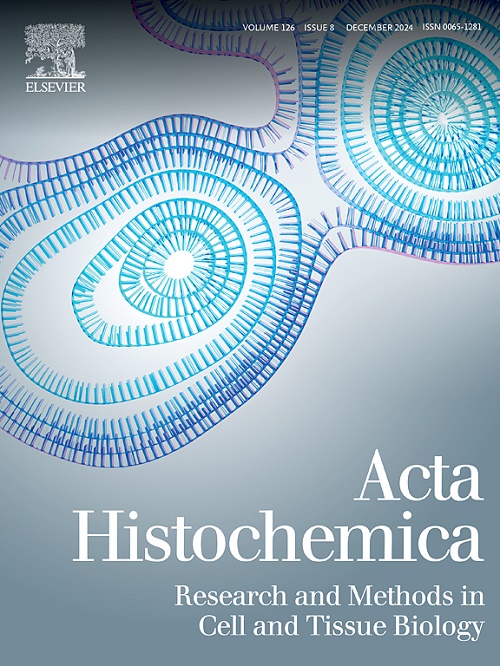Neurochemical heterogeneity of ChAT-immunoreactive neurons in the basal forebrain cholinergic nuclei and striatum in reference to CGRP, CCK, and calcium-binding proteins
IF 2.4
4区 生物学
Q4 CELL BIOLOGY
引用次数: 0
Abstract
Cholinergic neurons in the basal forebrain cholinergic nuclei (BFCN) and neostriatum (CPu) play key roles in learning, attention, and motor control. The loss of cholinergic neurons causes major neurodegenerative diseases such as Alzheimer’s disease. This study aimed to elucidate the molecular diversity of choline acetyltransferase immunoreactive (ChAT-ir) neurons in these brain regions. We performed immunohistochemistry to determine the co-expression of ChAT-ir neurons with two neuropeptides, calcitonin gene-related peptide (CGRP) and cholecystokinin (CCK), as well as three calcium-binding proteins, such as calbindin, calretinin, and parvalbumin, in the adult mouse brain. The results showed that ChAT, calbindin, CGRP and CCK were strongly expressed in the BFCN, including medial septal nucleus (MS), nucleus of vertical limb and horizontal limb of the diagonal band of Broca (VDB and HDB), substantia innominata basal part (SIB), and in the caudate putamen (CPu). CGRP and CCK showed a high immunoreactive co-expression with ChAT, especially in the HDB and CPu. Calbindin immunoreactivity was widely present and coincided with ChAT in the VDB, HDB, and CPu. However, calretinin immunoreactivity showed a selective co-expression with ChAT in the VDB, SIB, and CPu. Although parvalbumin immunoreactivity was observed throughout the BFCN and CPu, but there was no co-expression between ChAT and parvalbumin. The neurochemical diversity of ChAT-ir neurons in the BFCN and neostriatum suggests the specialized functions of cholinergic neurons across different circuits, especially by modulating CGRP, CCK, or calbindin. These results could provide new insight into cholinergic modulation throughout the BFCN and striatum.
基底前脑胆碱能核和纹状体中chat免疫反应神经元的神经化学异质性与CGRP、CCK和钙结合蛋白相关
基底前脑胆碱能核(BFCN)和新纹状体(CPu)中的胆碱能神经元在学习、注意和运动控制中起关键作用。胆碱能神经元的丧失会导致主要的神经退行性疾病,如阿尔茨海默病。本研究旨在阐明这些脑区胆碱乙酰转移酶免疫反应(ChAT-ir)神经元的分子多样性。我们采用免疫组织化学方法测定了ChAT-ir神经元与两种神经肽(降钙素基因相关肽(CGRP)和胆囊收缩素(CCK))以及三种钙结合蛋白(calbindin, calretinin和parvalbumin)在成年小鼠脑中的共表达。结果显示,ChAT、calbindin、CGRP和CCK在BFCN中,包括中隔核(MS)、Broca斜带纵肢和水平肢核(VDB和HDB)、基底基底物质(SIB)和尾状壳核(CPu)中均有强烈表达。CGRP和CCK与ChAT具有较高的免疫反应性共表达,特别是在HDB和CPu中。Calbindin免疫反应性广泛存在,并与VDB、HDB和CPu的ChAT一致。然而,calretinin的免疫反应性与ChAT在VDB、SIB和CPu中选择性共表达。虽然在BFCN和CPu中观察到细小蛋白的免疫反应性,但ChAT与细小蛋白之间没有共表达。BFCN和新纹状体中ChAT-ir神经元的神经化学多样性表明胆碱能神经元在不同回路中的特殊功能,特别是通过调节CGRP, CCK或calbindin。这些结果可以为胆碱能在BFCN和纹状体中的调节提供新的见解。
本文章由计算机程序翻译,如有差异,请以英文原文为准。
求助全文
约1分钟内获得全文
求助全文
来源期刊

Acta histochemica
生物-细胞生物学
CiteScore
4.60
自引率
4.00%
发文量
107
审稿时长
23 days
期刊介绍:
Acta histochemica, a journal of structural biochemistry of cells and tissues, publishes original research articles, short communications, reviews, letters to the editor, meeting reports and abstracts of meetings. The aim of the journal is to provide a forum for the cytochemical and histochemical research community in the life sciences, including cell biology, biotechnology, neurobiology, immunobiology, pathology, pharmacology, botany, zoology and environmental and toxicological research. The journal focuses on new developments in cytochemistry and histochemistry and their applications. Manuscripts reporting on studies of living cells and tissues are particularly welcome. Understanding the complexity of cells and tissues, i.e. their biocomplexity and biodiversity, is a major goal of the journal and reports on this topic are especially encouraged. Original research articles, short communications and reviews that report on new developments in cytochemistry and histochemistry are welcomed, especially when molecular biology is combined with the use of advanced microscopical techniques including image analysis and cytometry. Letters to the editor should comment or interpret previously published articles in the journal to trigger scientific discussions. Meeting reports are considered to be very important publications in the journal because they are excellent opportunities to present state-of-the-art overviews of fields in research where the developments are fast and hard to follow. Authors of meeting reports should consult the editors before writing a report. The editorial policy of the editors and the editorial board is rapid publication. Once a manuscript is received by one of the editors, an editorial decision about acceptance, revision or rejection will be taken within a month. It is the aim of the publishers to have a manuscript published within three months after the manuscript has been accepted
 求助内容:
求助内容: 应助结果提醒方式:
应助结果提醒方式:


